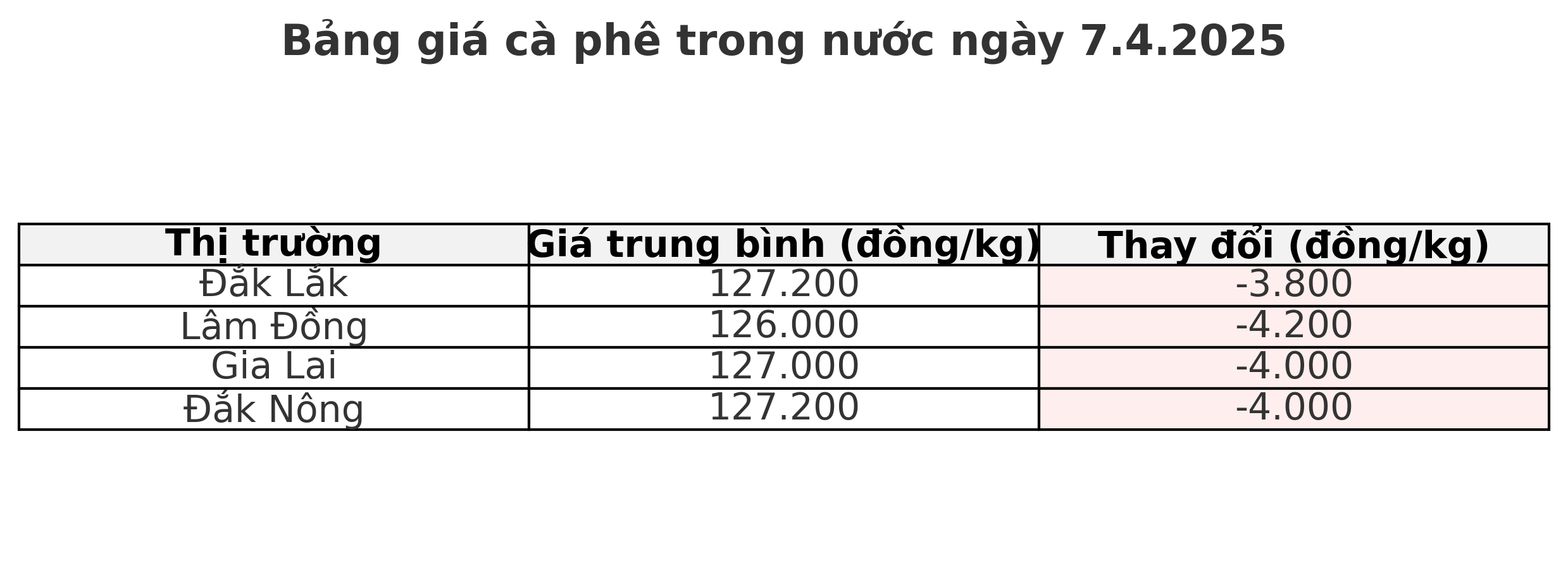Domestic coffee prices continue to decline
In the domestic market, coffee prices today, April 7, recorded a deep down trend in all key regions. In Dak Lak, coffee prices decreased by VND3,800 compared to yesterday, down to VND127,200/kg. In Lam Dong, coffee prices are currently trading at 126,000 VND/kg, down 4,200 VND.
Similarly, Gia Lai recorded a coffee price decrease of VND 4,000, to VND 127,000/kg. In Dak Nong, coffee prices also decreased by VND4,000, trading around VND127,200/kg.
The sharp decline in the domestic market reflects the impact of the international market and the cautious psychology of enterprises, in the context of concerns about global trade tensions.

World coffee prices continue to plummet
On London, Robusta coffee prices today dropped sharply in most terms. May 5.2025 decreased by 259 USD, to 5,112 USD/ton. The July term of 7.2025 also decreased deeply 283 USD, to 5.105 USD/ton. With the September term, the Robusta price back 245 USD, to 5,082 USD/ton. Meanwhile, the further term is November 2025 recorded a decrease of US $ 235, closing at 4,996 USD/ton.
This sharp decline in Robusta is reflecting negative sentiment from the international market, especially concerns related to US tariffs on Vietnamese coffee.
On New York, the price of Arabica coffee also inevitably plunged. Specifically, the term delivered in May 5.2025 decreased to 19.55 cents, closing at 365.70 cents/lb. In July 7, 2025 decreased by 18.45 cents, to 363.30 cents/lb. Term of September 2025 decreased by 17.85 cents, trading at 359.15 cents/lb. Meanwhile, the term of December 2025 also decreased by 17.20 cents, to 352.75 cents/lb.
Both international coffee exchanges were in the red, marking the deepest decline in many weeks. This development comes from concerns about slowing global coffee consumption demand, combined with instability from trade tensions between the US and partners.

Coffee production faces many challenges
In Dak Nong, there are currently about 143,000 hectares of coffee, of which 131,000 hectares are being harvested, with an average yield of about 2.6 tons/ha. The province's total coffee output in 2025 is forecast to reach about 343,000 tons.
However, production is being significantly affected by drought and climate change. Farmers must strengthen care measures to protect their gardens. Some households have boldly invested in small-drip irrigation systems to save water and optimize costs.
In Dak Lak - the coffee capital of the country with more than 212,000 hectares and an output of about 354,000 tons, erratic weather conditions, degraded land and increasingly large international competitive pressure are also posing many challenges.
Farmers and businesses have made efforts to innovate farming methods, increase the application of science and technology to improve product quality, and meet strict requirements from export markets, especially European anti-deforestation regulations (EUDR).
Coffee businesses worry about the risk of being taxed by the US
The US is Vietnam's third largest coffee export market, especially important for deep-processed products such as ground, instant coffee. Faced with the risk of being subject to a 46% tax, many businesses and cooperatives in Dak Lak have proactively prepared response plans.
Sharing with Lao Dong, some export orders to the US have had their transaction deadlines delayed pending negotiations. Businesses are willing to reduce prices, even accept that they are not profitable to retain partners and maintain the market.
In addition, many units are considering solutions to reduce production costs, increase product value and expand exports to other markets such as the EU, China, Japan, and South Korea.
Forecast
In the short term, world coffee prices may continue to be pressured by tariff concerns and abundant supply from Brazil. The domestic market is expected to adjust according to international price developments.
In the long term, the Vietnamese coffee industry needs to focus on improving quality, increasing added value and complying with sustainability standards to maintain its position in the global market.











